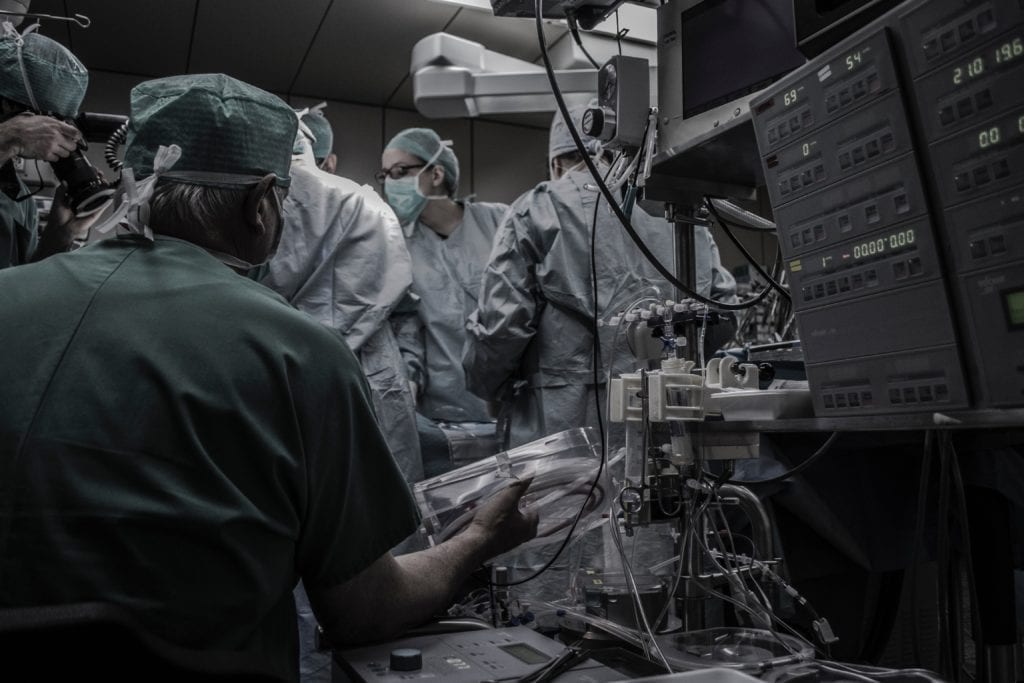Samantha Below
Milwaukee, Wisconsin, United States
 |
| The hospital. Photo by Piron Guillaume on Unsplash |
Thread passes from the tools in your hands to be pulled by mine. You suture the vessels. I clear the path of knots. Our posture is separated by inches, our hearts by hand-breadths. Our hands are identical in the vibrations of our nervous systems; mine reflect a lack of experience, yours a lack of dopamine. Your hands are slow, weighed down by experience. My hands are slow, weighed down by fear. Our hands are covered by the same thick white gloves, but underneath your surgeon’s hands bear evidence of many operations and vacations in the Caribbean. The skin of my hands confirms I have not experienced much of life at all. The suture is black and passes through pale pink vessels. I hold the small retractor like a Zen garden rake, to pull the creamy skin and yellow fat and shreds of pink muscle away from the path of the suture. The patient was covered in blue and speckled with pink, as if she was wrapped in the sky, far above the effects of gravity and the earthly examination of dust and rocks.
There are so many clots; clots in her vessels, her legs, her aorta. Platelets had precipitated out of the plasma like rock candy. Instead of doing their job, keeping her lifeblood inside of the vessels, too many had clumped together and robbed her of oxygen after what should have been a routine surgery. So now here we stand, our hands connected by a thread. You are five months from retiring and playing with your grandkids. I am five months from graduating and taking on your degree. But right now we are separated by inches, tied together by drama and goals.
We open the skin of her legs to release the pressure of swelling cells. We mumble for scissors, cut open tense fascia. We irrigate as potassium leaves the cells and runs through the body, like a dust storm. Technicians begin to move faster, fumbling for items and anticipating thoughts. The room grows quiet as our nimble hands surround the space from the hips to the toes with white gauze, but the potassium still has its way with her heart. The EKG machine blinks red and begins to beep.
No one calls out a code. The nurse jumps up on a step and begins to press on her chest, trying to stop her blood from reaching a standstill.
Then the LORD God formed the man of dust from the ground and breathed into his nostrils the breath of life, and the man became a living creature.
We watch him push on her chest. We force air into her lungs.
In the beginning God created the Heavens and the earth. The earth was without form and void, and darkness was over the face of the deep.
And darkness covers our faces. We hold our breath and watch the rhythm of her heart, a rhythm not compatible with life. She is moved to another room and the attempts at resuscitation continue. I look at her form, and feel alone; the only one without a part in this charade. It was your last death; it was my first. A marker for us both. Like the suture pulling us close. I go back to the OR, where they are cleaning up the formless blood on the table and the floor. There you sit, hunched over from your spine. Looking at the room as if this whole thing was a problem with design.
“Got your stuff?” you ask.
“Yes, thanks.” I pick up my bag.
“See you tomorrow,” implying that I was not a nuisance, which I had often felt. Which, on a different day, would have put me on a cloud.
“Today is my last day.”
You nod. There is no need to put forth an effort to be genteel.
And I leave before you see it in my eyes, the surprise this education does not allow us to immortalize. The tears fall fast as I drive back home, safe to cry now that I am alone. But perhaps this too is a thread that binds us.
SAMANTHA BELOW was born in Waukesha, Wisconsin where she spent most of her childhood reading books and playing capture the flag. Her first medical procedure was to save the life of a toad that had drowned in a sandbox by cardiopulmonary resuscitation. She enjoys studying mechanisms of disease and drugs during the day. She spends her evenings running and playing tennis, as well as reading and writing about experiences in and out of clinic.

Leave a Reply